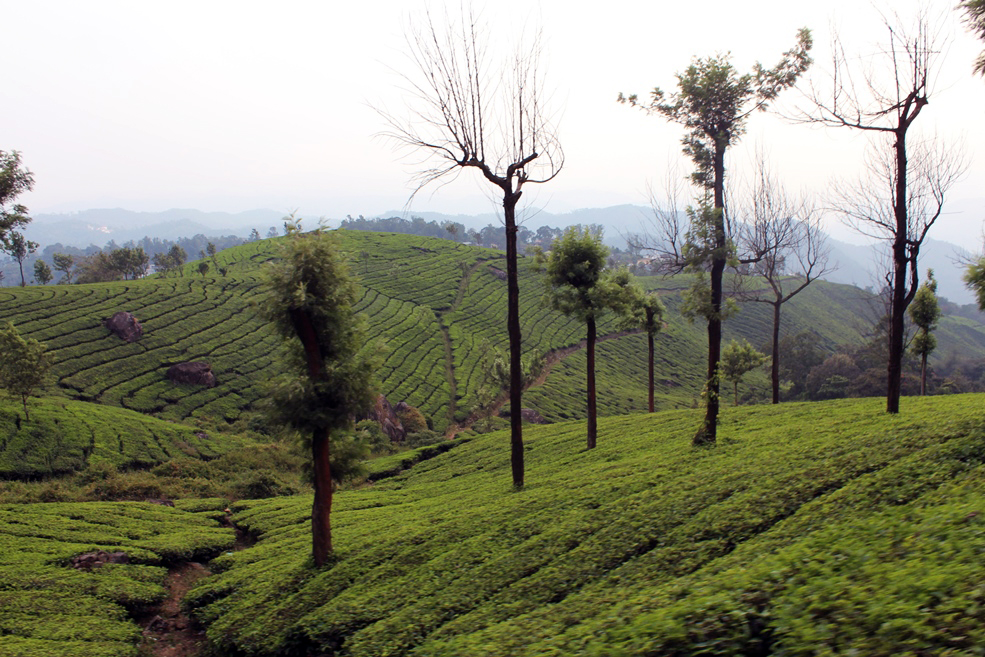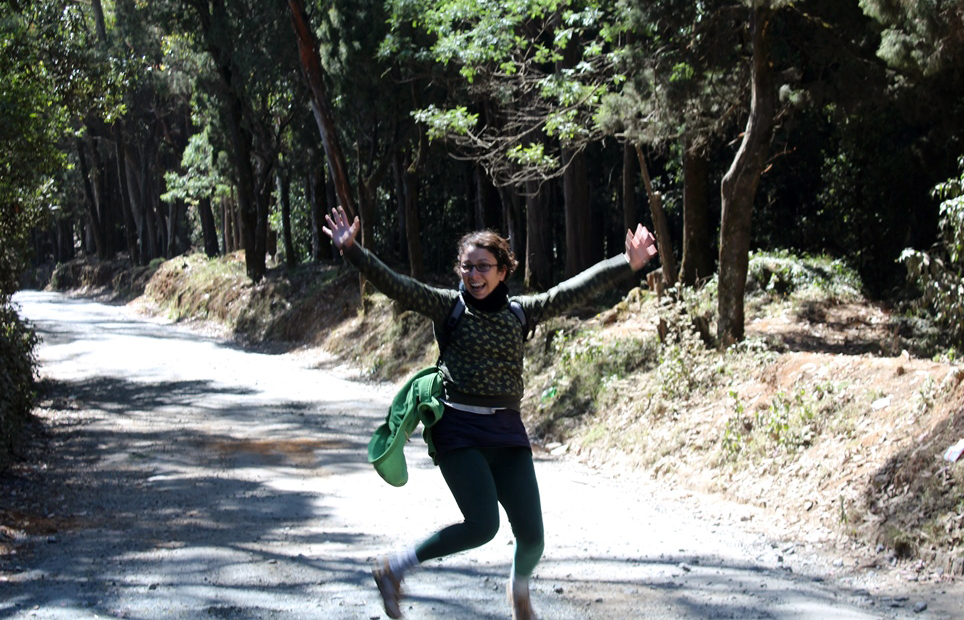Coming back to India after Sri Lanka, first we stepped into the capital of Kerala, Thiruvananthapuram (or Trivandrum), and our first thought was like: “Hello again the smell of urine, hello crazy sound of horns”… But interestingly, we felt ourselves back home again.
Kerala, is the western of two states sharing the south part of India (The other one is Tamil Nadu. E.g. Chennai, Ponducherry and Madurai). This time the local language is Malayam, English speaking level is very high. According to Lonely Planet, this is the place with highest level of literacy in India (approx. 100%). We indicated that there is a different culture in every state of India. When we first written about that, we hadn’t experience yet, we just heard of it. We understand what it means when we arrive Kerala.
First, we are going to Kovalam, 40 minutes south of Trivandrum. We weren’t planning to go there actually but, our hosts were living there who accepted our Couchsurfing request. Grigory and Ulyana is a Russian couple who is living in India for some time and working as tourist guides. They work very hard but we come together at dinner. Grigory is an adventurer who travelled to many places on the earth. He even experienced passing over a river in Tibet illegally with his bike on his shoulders. They also give us a short photography course as they are both professional photographers.
Kovalam, one of the famous beaches of Kerala, is a center of Ayurvedic treatment and Yoga Schools. It’s highly touristic, more expensive compared to the average of India, but a calm holiday resort. Average age of the tourist is higher than the other beaches. We spent our two days here mostly sitting in front of our computer as we wanted to prepare our blog about Sri Lanka and trying to get used to being in India again.
Then we go to the main city, Trivandrum, to explore again and stay with Umang and his friends who accepted us via Couchsurfing. Our decision to sleep on the rooftop, as it is very hot even in January, gives us a cold that lasts for 2 weeks. Because of that we spend most of our time in Trivandrum at home, drinking ginger tea. But, we learn lots of thing about India and the universe thanks to our aerospace engineer friends.
A couple of days later, we pass to Varkala, which is at the north of Trivandrum, by train. Another famous beach of Kerala. Actually our aim wasn’t to see a beach, we just visit as it is on our way, but we spent very nice time there.
Varkala is a very calm and relaxing coastal town; even it is a touristic place with its thin white sand beach and lovely restaurants and pensions, placed on two cliffs called the “North Cliff” and the “South Cliff”. At the north part of the beach, called the “North Cliff”, there are both backpacker friendly hostels and expensive hotels. But none of the buildings ruin the beauty of this place covered by long coconut trees. The silent of the beach starts at a bit south. Luckily, we find a nice and cheap room (500 Rs.=9$) just at this point called “The Palm Beach Resort”, thanks to the tuktuk driver we met at the train station. Behind there, on a hill far from the sea, Government Guesthouse stands, which is quieter and feels like you are in the forest. It is possible to stay there for 430 Rs. for per night.
Our first week in Kerala makes us feel the difference between Tamil Nadu, where we spent one month. Kerala is a developed touristic part of India, which makes it a place for tourist feel relax and swim in the ocean wearing what they want. Maybe because of that feeling, there we swim for the first time in India. And every day, watching the sunset… An advantage of travelling through the west coast is the amazing sunsets. Of course all this beauty and relaxation is felt in the prices. Our budget was 700-100 Rs. per day in Tamil Nadu; here we can hardly survive with 1200-1500 Rs, without joining any touristic activity and shopping.
Our next stop is Amritaphuri Ashram, close to Kayankulam, which we arrived after a train trip. It is founded by the most respected woman guru among Hindus, known as “Amma” or “Hugging Mama”, Mata Amritanandamayi Devi.
Amma is an interesting guru, known by hugging people, who has followers around the world. Thousands of people participate in her hugging sessions and sometimes she hugs for 22 hours without a break. We saw that people cry crazily while hugging her in the video shown on the first day of our arrival to the Ashram. She has small photographs everywhere in the Ashram, from elevators to the rooms. Everybody living in the Ashram respects Amma very much. Even more that respect, she is a real religious leader.
Also, as we learned from the orientation video, she has really good will. She is also the founder of a NGO called “Embrace the World” which helps people affected by natural disasters around the world, working for women rights, handing out free food. They must be collecting a high amount of donation that, they donated millions of dollar for a tsunami in USA.
While expecting a simple place, we find ourselves in a dense settlement in which there are two building with 15 floors and some other building with 5-6 floors on a small area. Other than the short term visitors like us, people from different nations lives for a long time in the Ashram and the total population is approximately 2000. 250 Rs/per day for per person (approx. 4 $) is paid for accommodation including 3 meals a day. For westerners who may get bored of eating juicy rice with veggie sauce in every meal, a Western Café is founded. Prices are affordable and of course everything is vegetarian.
Visitors can participate in the daily work in Ashram (Seva) or Hindu praying organized in the morning and the evening if they want. Joining the other courses (Yoga, Ayurveda, Tarot etc.) is charged. Consuming alcohol and tobacco in the Ashram is forbidden. And taking photographs.
Amma was in a tour in India when we were there, so we couldn’t hug her and join her meditation events. As we found Yoga Courses very expensive (4 days beginner course 5000 Rs), we decide to leave without doing anything but observing life in Ashram after two days.
One of the most important reasons of our visit in Kerala is its famous Backwaters. We take the Kollam-Alleppey ferry passing just in front of the Ashram and reach Alleppey in the evening after a trip for 6 hours.
Backwater cruises are the most important attraction for tourists in Kerala. You can also spend the night on the water by renting a Houseboat for 3000 Rs. Or you can join daily tours for 3-7 hours by paying at least 800 Rs per person. It is said that Alleppey is the cheapest place to join these tours. But we spend the night in a cheap room and move towards Cochin (Kochi) the following day to keep in our budget.
Cochin is a harbor city which was colonized both by the Dutch, the Portuguese and the British. There are many historical churches and synagogues in its historical part called Fort Cochin. We hear that there are some, but we don’t run into any Hindu Temple. Even the names of the people are not like Hindu names; Sebastian, Manuel, George…
It is very touristic city again with backwater tours, historical structures, yoga course and the temptation of spice markets. Streets are very busy when we are there, because of Biennale. When the pensions are not enough to host all these people, local people turns their homes to Home-Stays (houses for rent daily). It is possible to stay nearly in every house close to the center. And of course everything is expensive for us.
There we stay in a Home-Stay called Litte Flower. Renting a bike and wandering in the streets while being attracted by street art was the most enjoyable thing we did in Cochi. We meet the street artist Jaleel, who is famous with his art works against the Biennale.
Watching an ancient dance of Kerala, called Kathakali, is also another interesting thing to do in Cochi. But we didn’t join the show as we didn’t want to pat 400 Rs for each.
Kerala is one the important spice production regions of India. Many spice farms are located at hills, inland. We were dreaming of visiting one of these, in Thattekad, the farm of Motty who we found via Couchsurfing. But in the last minute, we learn that he will not be able to host us as he had to leave the farm. Then we move towards one of the most of Hill Stations of Southern India; Munnar. After a bus trip with couches slightly better than wooden benches, our bones shake when we arrive Munnar where even coconut trees don’t grow because of altitude.
With its tea fields all long the hills and trekking routes in the nature reservation area around, Munnar attracts many tourists. But it is too cold to visit in January (March-June is the right time), we get cold even we wear everything we have on and on. But the more important thing is that, the settlement has an irritating atmosphere for us and expensive (for our budget) and there is nothing to do if you don’t buy a tour. So, we leave Munnar the day after we arrive, early in the morning.
We decide not to visit Kodaikanal in Kerala, which is another Hill Station, as it is also very cold. We take a bus going north without knowing what to do. On the way, we realize that we have no problem with cold; we are just looking for sincerity and decide to go to Ooty where we were planning to go a couple of days later.
We pass to the north east of Tamil Nadu… And again, everything changes…









